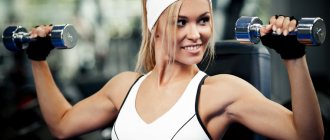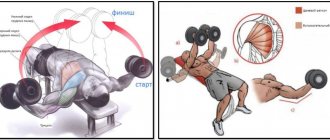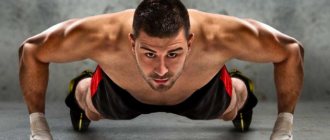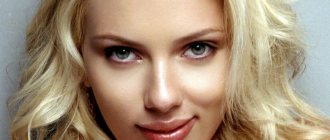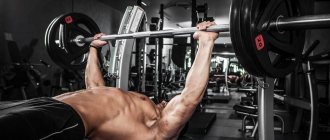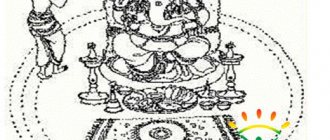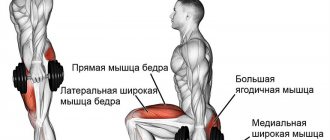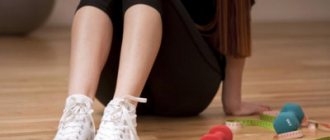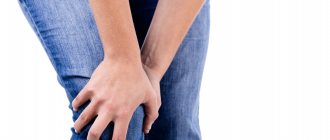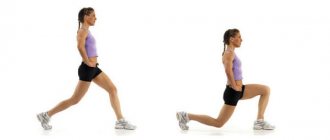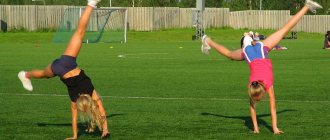Extending the arm with a dumbbell from behind the head pumps the top of the triceps (draws it) and the middle of all three of its heads. Isolation exercise.
Arm extensions with a dumbbell from behind the head are used in bodybuilding to equalize the development of the left and right triceps, to emphasize and thicken the top and middle of the triceps muscle. This exercise also very effectively separates the three heads of the triceps from each other and separates them from the deltoid muscle.
Straightening the arm is characteristic of all sports that involve hitting and throwing the ball from behind the head (tennis, volleyball and basketball), going into handstands (gymnastics, acrobatics), pushing away the opponent (American football, hockey), striking forward from the body and to the side (martial arts, boxing), repulsion from the projectile (pole vault, luge start). Therefore, by regularly increasing your triceps strength with our exercise, you will undoubtedly improve your results in these sports.
Overhead dumbbell extension - triceps exercise
One arm extension exercise
- Take a sitting or standing position and hold a dumbbell in your hand by a well-secured weight plate.
- Raise your hand up.
- As you inhale, bend your elbow and very slowly and smoothly lower the dumbbell behind your head.
- After a short pause, literally in two seconds, return your hand to its original position and exhale.
- During the entire training, it is worth monitoring the full contraction of the triceps. Also, when performing extension, you need to strain your abdominal muscles as much as possible and not arch your lower back.
- It is recommended to carry out this training in a sitting position on a bench with a backrest, which will help to properly fix the back and spine.
- This exercise can be performed by beginner athletes, but it is also suitable for professionals.
- It is better to do extensions in the second half of the workout, at a time when the body is well warmed up and not yet completely exhausted.
- The training can be performed in four sets of twenty repetitions.
Description of the exercise
The exercise is great for working out those areas of the biceps that are difficult to “hook” when working with a barbell or on block machines. Working with dumbbells does not require as much concentration on the correct position of the body as when lifting a barbell for biceps, and it is easier for us to establish a neuromuscular connection with the working muscle.
Any variations of dumbbell curls are not recommended for athletes who have suffered injuries to the elbow or shoulder joints and ligaments. When lifting a dumbbell, too much stress is placed on the incompletely healed area, which often leads to recurrence of the injury.
Strong arms are always an advantage, the path to which is focused training and diligence. The dumbbell overhead extension is an isolation exercise aimed at developing the triceps brachii muscle. This muscle, if it is sufficiently trained, forms the main muscle volume of the arm, so if you want to achieve results from normal fit to visible relief, introduce this type of load into your “Must do” training complex.
Extending the arm backwards with a dumbbell in an inclined position can be done with both hands or each one in turn.
- In the first case, you need to bend your knees slightly to achieve stability;
- and the second option involves resting the second hand on the bench to stabilize the movement.
When performing a sports set with one hand, you will be able to take more weight, thereby increasing the load on the triceps and making the workout more effective.
- Before starting the exercise, you need to straighten your back, bend your lower back and lower your body just above parallel to the floor.
- Press your elbow tightly against your body and maintain this position throughout the entire approach.
- Take the dumbbells in a neutral grip (with your palms facing your torso), take a deep breath, feel the tension in the line from shoulder to elbow, fully straighten your arm back, lifting the dumbbell slightly above the level of your back, then return to the starting position.
- It is important to keep your torso motionless, clearly controlling your movements, without wasting energy on swaying your torso.
Tip for beginners: pause for a second at the top and bottom.
Do not forget about proper breathing: at the end of the effort (when extending the elbow) - exhale, when bending - inhale.
Perform arm extensions with dumbbells while standing on an incline slowly, maintaining a calm pace.
It is better to bend over almost parallel to the floor. Extend your arm as usual to the end. do it at the end of the workout, when you no longer have the strength, but you need to fully abuse the muscles. It is better to use the exercise only as an auxiliary exercise, and only after basic triceps exercises.
Main features
1. Can be done with one or two hands. In the one-handed version, you can take a little more weight. Since only one hand works, and you use your free hand to lean on.
2. The tilt of the torso should be slightly higher than parallel to the floor. It is very important not to sway your body.
3. If you do it with both hands (without support on the bench), then your knees should be slightly bent.
4. The arm (its part from the shoulder to the elbow) must be parallel to the floor and fixed in a stationary position. The elbow should be pressed to the body.
5. To avoid swinging your arm, you need to take a short pause at the top and bottom of the movement. You need to straighten your arm all the way.
6. The weight of the dumbbell should be such that you can do at least 10 repetitions.
7. Alternatively, you can do this exercise in a crossover from the lower block. The principle is the same. However, the triceps in this case will experience the same load throughout the entire range of motion.
Nuances
In order for the training to be as effective as possible, you need to follow some rules and pay attention to the nuances.
- While the entire exercise is being performed, only the forearm should move, the shoulders and elbows should be completely motionless;
- Make sure that your elbows do not move apart and do not move them too far in different directions;
- The projectile should be directed downwards very slowly and purposefully, but upwards it can be lifted more aggressively, that is, the upward squeeze should be fast and powerful;
- Pausing for a few seconds at the bottom will help the trainee feel the maximum stretch of the triceps muscle;
- There should be no pauses at the top point;
- If the goal is to make the volume of your arms much larger in a small amount of time, then the training should be carried out at the very beginning of classes;
- In order for the spine to be in a neutral position, when performing the exercise, it is necessary to use the abdominal muscles, which should be strained as much as possible;
- The wrists can be located next to each other, this will help keep the elbows from moving apart;
- The shoulders should not be rounded, and the chest should be straightened as much as possible;
Extension of the arm with a dumbbell from behind the head
| Effect on muscles: Triceps: Long Bunch Triceps: Middle fascicle Triceps: Lateral bun |
Description
This exercise equalizes the development of the left and right triceps, emphasizing and thickening the top and middle of the triceps muscle. Also, it does a good job of separating the triceps heads from each other and separating them from the deltoid muscle.
Straightening the arms occurs in all sports that involve striking and throwing the sword from behind the head: handstands, gymnastics and acrobatics; pushing away an opponent in American football and hockey; punches forward and to the side from the body, in boxing and other martial arts; projectile repulsion; pole vaulting; Also, this exercise will be useful for tennis players, volleyball players and basketball players.
Exercise technique
Sitting on a bench, place your feet firmly on the floor. Straighten your back while holding a dumbbell in your right hand. Raise your arm with the dumbbell vertically up, your arm should be straight. Place the dumbbell behind your head, bending your arm at the elbow. The exercise is performed with a neutral grip - the little finger is higher than all the other fingers, and the palm “looks” forward. In the initial position, the elbow of the working hand should be directed upward, the torso should be in a vertical position, the back should be slightly arched in the lower back, and the gaze should be directed straight forward. Hold your breath by taking a deep breath. Squeeze your triceps and lift the dumbbell by extending your arm, keeping the top of your arm stationary. The movement should be performed only with the help of the elbow joint; all other parts do not take part in the movement.
When your arm is fully straightened at the elbow (this will be the top point of the exercise), hold your arm in this position for a couple of seconds and tighten your triceps even more and exhale. Smoothly bending your arm without relaxing your triceps, return the dumbbell to its starting position. After a short pause, proceed to the next repetition.
When you finish doing the desired number of repetitions with one hand, do the same number of repetitions with the other - this will be one approach.
Recommendations
If you round your back, this will cause your torso to lean forward, which means that the pressure on the spinal discs and shoulder joint will increase enormously. The back should remain straight and slightly arched at the lower back until the end of the set. During the entire exercise, the part of the arm from the shoulder to the elbow must be strictly fixed in a vertical position. If you do not do this correctly, the effectiveness of the exercise will decrease and the likelihood of injury will increase.
You can straighten your arm to the limit (that is, until it is fixed in the elbow joint) only when the arm is strictly perpendicular to the floor; if you are not sure that you can accurately determine this position, it is better not to straighten your arm to the end, otherwise there will be a very high probability of injury.
This exercise is unique. Its uniqueness lies in the fact that, depending on the angle of rotation of the forearm around its axis at the top point, you can work each of the triceps heads.
- If, during extension of the arm, the forearm remains in the initial position, and you do not turn it either inward or outward, and the palm faces forward, the long head is being worked out.
- If, while approaching the top point, you slightly turn your forearm so that your palm looks outward (away from the body), then the lateral head will be worked out.
- If you turn your forearm so that it looks inward, then the emphasis is on the inner head.
Regardless of which muscle you are working, make sure that your wrist is strictly fixed (not bent or unbent). Focus on the fact that the hand and forearm should be on the same line. If it is difficult for you to perform the exercise while sitting, you can do it standing.
Errors
- A non-horizontal tilt of the body will take some of the load away from the triceps.
- Any movement other than along the body will minimize the stress on the internal triceps bundle.
- Rotate the body towards the dumbbell.
Quite technically complex, but useful exercise for triceps with dumbbells.
You can do it standing or lying down. The second option is inconvenient because the back will interfere with straightening your arms. Therefore, you will have to spread your elbows slightly to the sides. It turns out that in this position the arms will be without support and are supported by the back. In addition to the triceps, the back along with the rear deltoids will also be loaded. It is better to avoid this, so it is better to perform the exercise while standing.
- Lean forward, place the same knee and palm on the bench. Turn your body slightly towards your working hand with the dumbbell.
- The elbow of the working arm is pulled straight back, the shoulder is parallel to the floor. The forearm is pointing down. During the exercise, the arm should be fixed from the elbow to the shoulder joint.
- Extend your arm and return the dumbbell to its starting position.
Dumbbell extension from behind the head
Workout -
Exercises
The dumbbell extension exercise from behind the head is performed mainly to train and develop the triceps (extensor muscles). Doing this exercise perfectly trains muscle strength. The difficulty of performing a dumbbell extension from behind the head is characterized as medium. Before you start doing the exercise, you should take a dumbbell and sit on a bench equipped with a backrest. The dumbbell is placed on the athlete's upper thigh. In addition to the “sitting” position, dumbbell extension from behind the head can also be performed in the “standing” position.
So, lift the dumbbell in your hand to a level above your shoulder, after which your arm straightens up, holding the dumbbell. During this lift, the hand should not protrude to the side, but should be close to the head. That is, you should hold your hand perpendicular to the floor strictly vertically. The other hand is free during the dumbbell extension from behind the head, but is usually placed on the belt. You can also grab any stationary surface with your other hand if that is more convenient for you. When the dumbbell arm is at the top of the range, the wrist should be rotated so that the palm is facing forward and the little finger of the hand is pointing toward the ceiling. This is the starting position when extending the dumbbell from behind the head.
While inhaling, very smoothly and very slowly the dumbbell lowers behind your head. The shoulders should remain completely motionless during this time. At the end of one movement there is a short pause. As you exhale, the athlete returns his arm to its original position, extending it from behind his head. Be sure to ensure that only your forearm moves during the exercise. The athlete's arm from elbow to shoulder must be completely motionless. After completing the required number of repetitions with one arm, perform an overhead dumbbell extension.
with the other hand. With exactly the same technique, this exercise can be performed not with dumbbells, but with the use of a cable machine.
Performing these overhead extensions with a dumbbell is an excellent way to develop the triceps, and this development is performed in isolation. If your training plan is to do dumbbell extensions from behind your head with a light weight, then you can perform this exercise any way you like – either sitting or standing. But if you have to work with serious weights, then you should not risk your back - be sure to do the exercise while sitting so that there is support under your back. For example, Scott's bench is perfect for this, you just need to sit in reverse. Or an ordinary chair with a short back. If you plan to work with near-maximum weights, then you probably shouldn’t do the exercise yourself - ask your partner to be your assistant. Remember - safety comes first!
What muscles work
When performing an arm extension with a dumbbell from behind the head, the triceps works, with its long head receiving the main load. It is almost not involved in most exercises to work this muscle. This is why it is worth including the French press in your training program.
For men, the exercise will help to make truly large and strong arms, all parts of which will be developed evenly and proportionally.
For girls, the French press will help get rid of fat deposits in the area of the long head of the triceps. Almost everyone has them, and they should be given special attention in order to quickly get rid of this excess fat. The result will be slender, toned and beautiful arms.
Common Newbie Mistakes
As a rule, lack of experience leads to unpleasant consequences, especially in weightlifting. Beginners make the same mistakes when bench pressing, which will be discussed below:
Using excessively heavy working scales. Many people naively believe that in this way it is possible to significantly accelerate muscle growth, but this only leads to injuries and sprains.
It is very important to choose the optimal working weight so that the last repetition is difficult. Correct posture and use of the belt. Do not neglect this important rule, because you do not want problems with the lower back or spine. No warm-up
This mistake is made most often, even by athletes with extensive experience. The first task before training is to thoroughly warm up your muscles and joints. If you have previously had any injuries to the shoulder girdle, you need to use special ointments to warm up before training. Before you begin lifting your usual weights, do a warm-up set with a lighter weight. If you neglect this rule, you can get seriously injured and completely forget about training for a long time. Many athletes do not pay attention to the correct range of motion. This is a common mistake that disrupts the technique of performing the exercise. As a result, the effectiveness of training decreases, muscle groups are not fully loaded and worked out. Jerks when lifting projectiles. This is directly related to incorrectly selected working scales. In addition, jerking can lead to very serious injuries, including displacement of the cervical vertebrae. You should avoid jerking, because our goal is not to get into bed, but to increase muscle tone.
Execution technique
It is very important to adhere to the correct technique; this is the only way to protect yourself from injuries and unnecessary additional stress. So, first things first:
Select the optimal weight of the equipment, take the dumbbells in your hands and straighten your back. Squeeze as you exhale, keeping your arms in sync.
It is important to control your core, not forgetting to monitor your posture. Also control your abs and lower back muscles, they should be in a tense state. At the top point the shells should be brought together. Lower the dumbbells to ear level, then do the required number of repetitions.
It is very important to use an athletic belt to reduce stress on the lower back and lower abdomen. At the initial stage, 10-15 repetitions in three sets are enough.
Monitor your results by gradually increasing the load. To gain muscle mass, it is recommended to do no more than 3-4 sets of 8 repetitions. The last repetition should be the most difficult for the athlete; it is at this moment that the muscle fibers are actively developing and growing.
Video: 6 exercises for training triceps with dumbbells
Before performing the main complex for training triceps, take time to warm up. Do joint exercises for the upper body. This way the muscles will warm up and be ready for further work. Finish your workout with a good triceps stretch.
If the goal is to increase arm muscles , work out the triceps with three exercises from a complex of 3 sets of 8-12 repetitions.
When the goal is to tighten problem areas of the arms , perform exercises following our complex. If you have enough strength, do all six. If the muscles begin to fail, do it as best you can. To shape your arms, it is recommended to do exercises of 3 sets of 15 repetitions.
